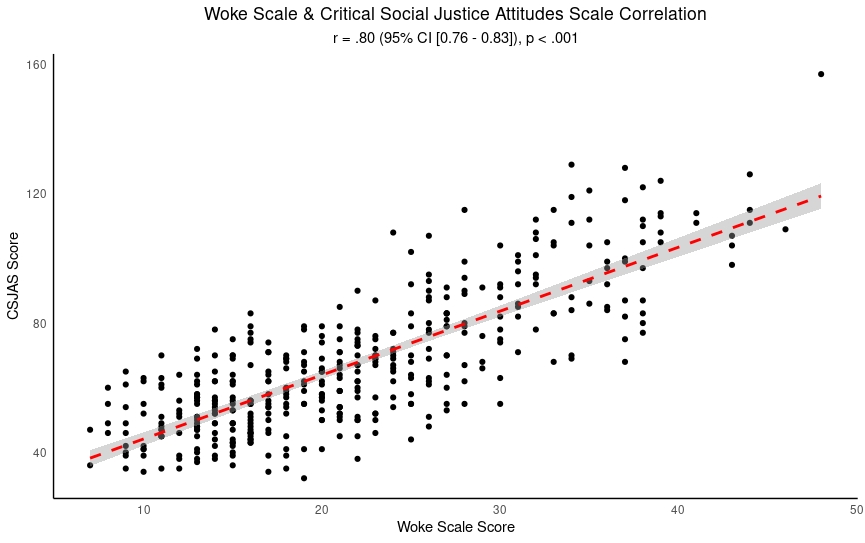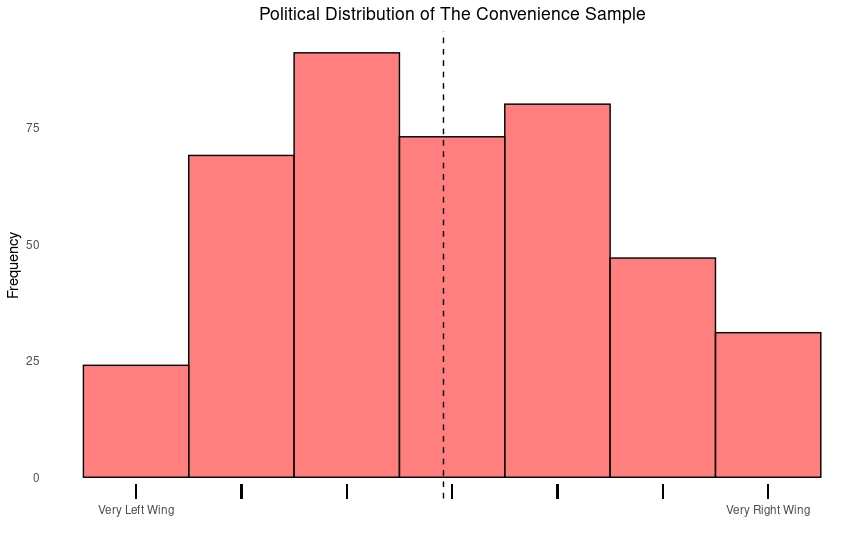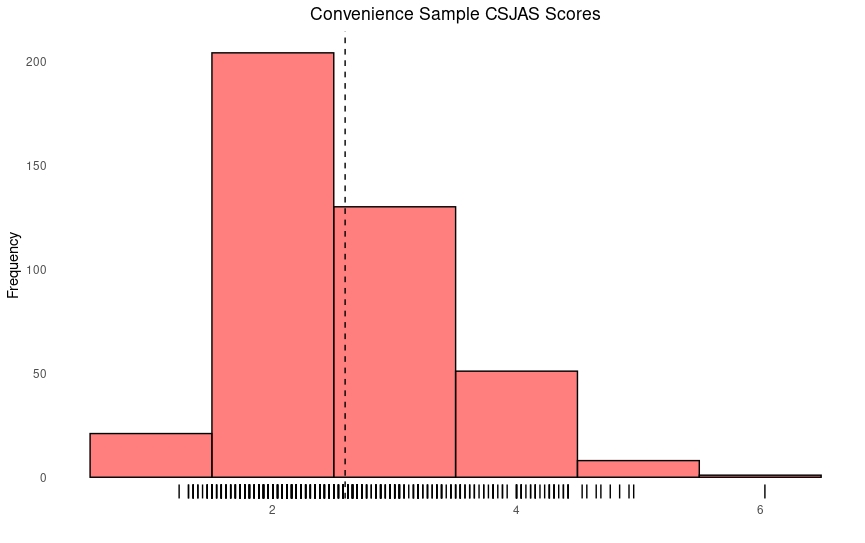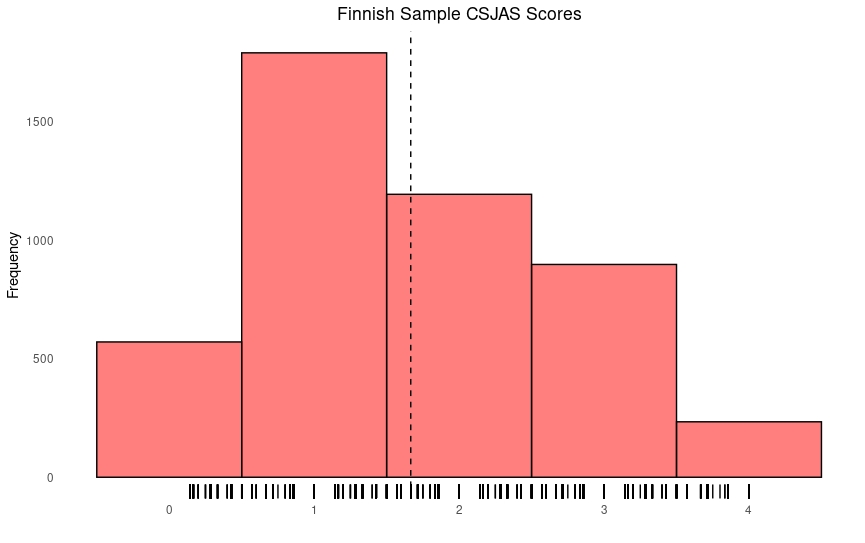Lahtinen (2024) recently developed and validated a scale for critical social justice attitudes (the CSJAS), or more colloquially “wokeness.” It’s a very good paper with very good methodology, utilizing large convenience and representative samples from Finland. It is open access so you can read it in full here: “Construction and validation of a scale for assessing critical social justice attitudes.”
We also developed and validated a scale to assess “wokeness” that we called the Woke Scale (WS) (links in the references). Here we will compare results from the CSJAS and the WS administered to a convenience sample.
Methods
415 participants were retained from a social media convenience sample (24.6% female) following the removal of 7 after failed attention checks. The mean age of participants was 34.4 (SD 11.4). Participants were administered the CSJAS (Lahtinen, 2024) and WS. Additionally, participants were asked to indicate their political affiliation from very left wing to very right wing on a 7 point scale.
Four items were used from Lahtinen (2024) assessing self-rated socioeconomic status, experience with oppression, support for political violence toward others, and the belief that external forces were responsible for their well-being. Self-assessed “wokeness” was measured from an item in Lahtinen (2024): “If my friend called me ‘woke’ in good faith, I would agree with them, regardless of whether I approve of the term or not.”
We scored items on a 7-point Likert scale, while Lahtinen (2024) used a 5-point scale for items.
Results
Pearson’s correlation was conducted to examine the association between CSJAS and WS scores. There was a significant positive correlation between the CSJAS and the WS (r(413) = .80, p < .001, 95% CI [.76, .83]) (Image 1).

The item “If my friend called me ‘woke’ in good faith, I would agree with them, regardless of whether I approve of the term or not” was used in Lahtinen (2024) to self-assess critical social justice attitudes. A significant correlation was found for the WS and this item (r(413) = 0.62, p < .001, 95% CI [.56, .68]) and for the CSJAS and this item (r(413) = 0.63, p < .001, 95% CI [.57, .69]).
There were significant negative correlations (the higher the scores on the scale, the more left-wing) between the two scales and political orientation. For the WS this was r(413) = -0.74, p < .001 with a 95% CI of -0.78 to -0.69. For the CSJAS this was r(413) = -0.68, p < .001 with a 95% CI of -0.72 to -0.63.
For the item “I have experienced significant oppression from others during my life,” no significant relationships were found with WS or CSJAS scores. For this WS the relationship with this item was r(413) = 0.07, p = .189, 95% CI [.57, .69] and for the CSJAS was r(413) = 0.08, p = .110, 95% CI [.57, .69].
There were no significant relationships between the item “I think of myself as being in a good scoio-economic position” and WS or CSJAS scores (WS, r(413) = -0.0004, p = .994, 95% CI [-0.097, 0.096]; CSJAS, r(413) = -0.07, p = .177, 95% CI [-0.162, 0.030]).
For the item “Other people and/or structures are more responsible for my well-being than I am,” there were significant positive correlations with both the WS and CSJAS. For the WS this was r(413) = 0.44, p < .001, 95% CI [0.35, 0.51] and for the CSJAS this was r(413) = 0.44, p < .001, 95% CI [0.35, 0.51].
Finally for the item “I think violence against politically dangerous people is justified” significant correlations emerged for the WS (r(413) = 0.17, p = .001, 95% CI [0.074, 0.261]) and the CSJAS (r(413) = 0.24, p < .001, 95% CI [0.144, 0.326]).
Table 1 shows comparisons of correlations between items:

WS and CSJAS Sex Differences
A t-test was conducted to compare the mean scores of the WS for men and women. The mean score for men was 21.59 and for women was 22.31. There was no significant difference between the two groups (t(156.4) = -0.701, p = .485, d = -0.08). For the CSJAS, a t-test revealed a significant difference between men (M = 65.98) and women (M = 71.84) (t(145.05) = -2.178, p = .031, d = -0.26).
Descriptive Comparisons of CSJAS Representative Data with Our Sample
Here is the political distribution of our social media convenience sample:

We visualized CSJAS scores of our convenience sample and the representative Finnish sample. The mean CSJAS score in the representative Finnish sample was 1.67 out of 4 and in our convenience sample was 2.59 out of 7. To compare these on a 10-point scale, the Finnish sample had a mean score of 4.2 and our convenience sample had a score of 3.7.


At a glance it looks like our sample is less woke than the Finnish population.
Result Summary
- The WS and CSJAS correlate highly at .80.
- Correlations between WS and CSJAS scores and items used in Lahtinen (2024) are very similar.
- No sex differences emerged for WS scores, but did emerge for CSJAS scores.
Discussion
When we made the WS we got a little bit of push-back from individuals who questioned if it measured “wokeness.” In the WS we used the binary item “Thinking of the term “woke,” would you describe yourself this way or do you believe others might describe you this way?” to test if participants who self-assessed as “woke” would indeed score higher on the WS. We found a large difference: Cohen’s d of 2.04 for participants who answered affirmatively versus those who answered negatively. In the current results, following Lahtinen (2024) we used the item “If my friend called me ‘woke’ in good faith, I would agree with them, regardless of whether I approve of the term or not” and found a correlation of .62 with the WS and agreement on this item, while the CSJAS resulted in a correlation of .63.
In other words, across two items from separate surveys the WS predicted self-recognition as “woke” and performed as well as a recently validated measure for assessing “wokeness” (the CSJAS). WS and CSJAS scores had a high correlation (.80) and also predicted similarly-sized correlations across the four items selected from Lahtinen (2024).
WS and CSJAS scores predicted higher scores on the item “Other people and/or structures are more responsible for my well-being than I am.” This is an interesting one, because it is very reminiscent of an item that might assess locus of control. Further research might explore the relationship between “wokeness” and an external locus of control.
References
Lahtinen, O. (2022). Construction and validation of a scale for assessing critical social justice attitudes.
DatePsychology: Who will date an OnlyFans worker? The woke.
DatePsychology: What is woke? Further validation of the woke scale.